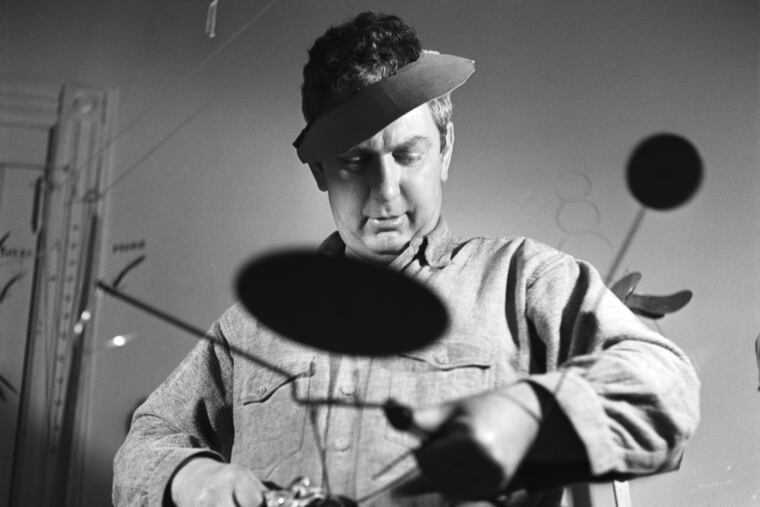My family’s Calder mobile could have changed my life. It ended up being a fake.
For generations, we had venerated a mobile that my grandfather said was an original piece by Alexander Calder. When it got to me, I decided to investigate.

My family, like probably a few others who have lived in Philadelphia for a few generations, has a Calder story. Mine began with my grandfather.
I didn’t know my grandfather. But for a while, he was known.
William McCook used to own Cliveden Yarns at Seventh and Arch. He died long before I was born, and no one talked about him when I was growing up, but at one time, Cliveden Yarns was a big deal. According to the vintage catalogs — which you can still buy online — it was one of the largest retail stores in the country. Once, when I used a credit card at a yarn store in Chestnut Hill, the staffer saw my name and asked if I belonged to the family that owned Cliveden Yarns.
So when my grandfather told everyone he bought an original work of art by Alexander Calder, maybe sometime in the 1940s or ‘50s — a mobile made up of metallic shapes that was roughly two feet tall and three feet wide — it wasn’t so far-fetched. It looked like one of the artist’s signature works, and the new Calder museum planned for the Parkway will likely be filled with others just like it.
» READ MORE: The project seemed dead. But after a 25-year delay, a Calder museum is finally coming to the Parkway.
Over the years, my family talked about our Calder more than they talked about my grandfather. My grandmother hung it over the stairs, then when she died, my dad inherited it. When my dad moved into an apartment at Cathedral Village in Roxborough at the end of 2013, I hung the mobile next to his recliner. As his health worsened and he needed more help, the people coming in and out kept brushing up against it, causing the delicate shapes balanced on cantilevered wires to shimmy and twist out of place. Packing up his apartment after he moved to assisted living in June 2019, I realized I had to figure out what to do with an original piece of art.
First, it needed to be insured, which required an appraisal. I searched online, called anyone I found, and eventually, toward the end of 2019, someone pointed me to the Calder Foundation in New York.
They needed a professional color photograph of the work, which had to “present all aspects of the work in crisp detail,” set against a clean background with minimal shadows, all elements turned to face the camera. It took hours to try to place each moving piece perfectly, and the photographer needed two sessions ($200 total) to get the picture right.
I was elated when, on Jan. 9, 2020, the Calder Foundation told me the piece looked like an original, and it wanted to examine it on its next scheduled day, Jan. 20.
To transport it, I paid a local company $860 to design a custom case. The costs were adding up, but I kept telling myself it was an investment. My grandfather said it was an original Calder, a piece of Philadelphia history. It was worth it.
The day of the exam, I stood in line at a loading dock on West 25th Street in Manhattan with about five or six other people, all of whom were there for the same reason. We didn’t say much to each other. I dropped the piece off at 10 a.m., had lunch with a friend who worked nearby, then picked it up at 3 p.m. I never saw any examiners, nor learned about their process.
I had to wait a week for the results, during which I was a bundle of nerves. Was I going to be a millionaire? Would this piece of art change my life?
Finally, the moment arrived, and I called; I sat on hold with bated breath. The appraiser came on.
It isn’t a Calder, she told me.
I was silent for a beat, stunned. What?
I’m sorry, she said. He was so popular that a lot of artists emulated him, and some of those works have been misattributed to him. At most, it was worth a couple hundred dollars, she said. Then apologized again.
When I found out that my family lore was a lie, I was crushed. (My millions!) But I wasn’t totally surprised. Because just as the myth of my grandfather’s Calder fizzled out, so, too, did Cliveden Yarns.
The once massive family business was supposed to pass to my dad one day; since I was an only child, it would have likely passed to me. But as anyone who knows what Seventh and Arch looks like today, that didn’t happen. My grandfather drank too much, died young, and the business died soon after.
I won’t ever know if my grandfather was swindled or if he had swindled us, knowing it was a knockoff and telling everyone it was an original. Either way, I think he would have been pleased to hear that Philadelphia was going to be home to a new Calder museum, located a short walk from where Cliveden Yarns used to be.
I imagine he would have strolled through the collection, pointing at the various mobiles, and told anyone who would listen: “I have one just like it.”
Alison McCook is an assistant opinion editor at The Inquirer.